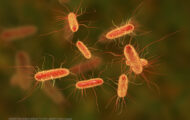Neurologists at UCLA have uncovered a link between pesticides and the development of Parkinson’s disease. So far, three chemicals – paraquat, maneb and ziram – have been linked to increases in the disease among farmworkers and those who live and work near fields where they are applied. The disease occurs at high rates among farmers and those who live in rural areas.
 This new study found a link between Parkinson’s and benomyl, a pesticide that was used on farm fields until 2001. The study is published in the Proceedings of the National Academy of Sciences.
This new study found a link between Parkinson’s and benomyl, a pesticide that was used on farm fields until 2001. The study is published in the Proceedings of the National Academy of Sciences.
Exposure to that chemical starts a “cascade of cellular events” that may lead to Parkinson’s. The pesticide stops aldehyde dehydrogenase (ALDH), an enzyme in the brain, from controlling DOPAL, a toxic metabolite of dopamine. When DOPAL accumulates, it damages neurons and increases the risk of Parkinson’s development. One of the critical results of this study may be that developing new drugs to protect the ALDH enzyme may help slow the disease’s progression.
The first author of the study, Dr. Arthur G. Fitzmaurice, said, “environmental factors almost certainly play an important role in this disorder. Understanding the relevant mechanisms – particularly what causes the selective loss of dopaminergic neurons – may provide important clues to explain how the disease develops.”
Benomyl was used in this country until scientists found it could cause liver tumors, cancer, and brain malformations. One of the more troubling aspects of the study is that the effects of pesticides and other toxins can linger long after we stop using them.
Researchers can’t subject people to pesticides in studies because that would violate the principles of medical ethics. So they test pesticides on cell cultures and found that it “damaged or destroyed dopaminergic neurons”. They then tested the pesticide on zebrafish, and discovered “significant neuron less in the fish – but only to the dopaminergic neurons,” which are the main source of dopamine in our central nervous system.
Until this research took place, scientists thought that a protein called α-synuclein was mostly responsible for the disease. That protein, which is found in all Parkinson’s patients, binds together in clumps and lumps. The protein’s toxicity kills the brain’s neurons, leading to the disease.




